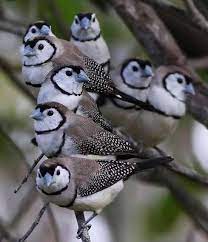
Pairing
You can pair the Owl Finch with another Owl Finch. They will get lonely and depressed if they are the only Finch. You can even pair them with other species of Finches and Canaries. They are peaceful birds and won’t usually cause any problems.The only situation where there might be a territorial issue is if you keep four Owl Finches or two couples. They may get competitive with one another. However, bird keepers have found this problem is easily remedied by adding a third pair.
Cage
The Owl Finch is a small bird, but they need a great deal of space. It’s recommended that they live in an aviary or a large cage with plenty of avian company. These birds hate to be crowded, so the enclosure should give them plenty of freedom to move around.They also need to be able to build their own nests, so you’ll have to supply them with dry grasses, coconut fiber, paper, and a wicker basket. They’ll happily use these materials to build nests.These Finches also cannot survive in extreme temperatures. They shouldn’t be kept in a place where the temperature dips below 65 degrees Fahrenheit or where it gets too hot.
Entertainment
The Owl Finch is a wild animal and thus, doesn’t need as many toys or activities as other birds more commonly bred as pets. That’s not to say that they should be in a bland enclosure, however. You should provide them with many plants, branches, and nesting areas. They also need materials that they can use to build nests because this is how they like to spend much of their time .
Grooming
The biggest grooming need for an Owl Finch is nail and beak trimming. This must be done by an avian veterinarian. Otherwise, these birds will take care of their own grooming needs. Make sure they always have access to fresh, clean water.
Common Health Problems
The Owl Finch is known to be relatively healthy if kept in proper conditions. They need bird companions and plenty of space. If the conditions are right, then the only illnesses they are prone to are:
- Egg binding: This is caused by a bird’s inability to lay their eggs naturally. Typically, a low-calcium diet is the reason. It can be fatal if not treated by a qualified veterinarian.
- Air-sac mites: These parasites can infect a Finch’s nose, throat, and lungs. In severe cases, they can be fatal. Less severe cases can still cause breathing problems and extreme discomfort for your birds.
Diet and Nutrition
In the wild, the Owl Finch primarily eats seeds. They may also occasionally eat worms and insects. In captivity, you should feed them a combination of seeds and bird pellets with occasional insect treats. They can also have fresh, green vegetables, like broccoli, spinach, and lettuce. You should provide them with a cuttlebone for calcium.